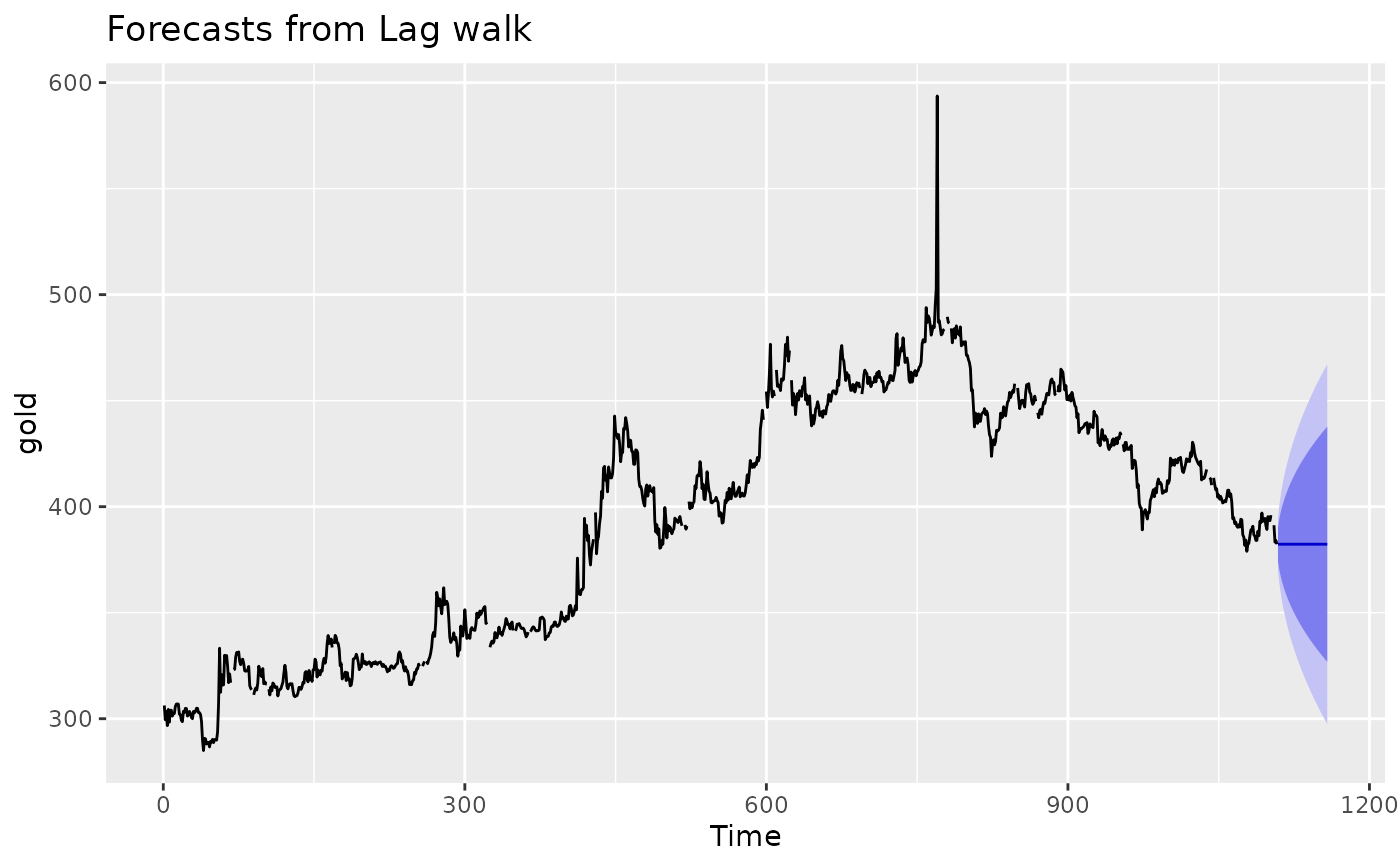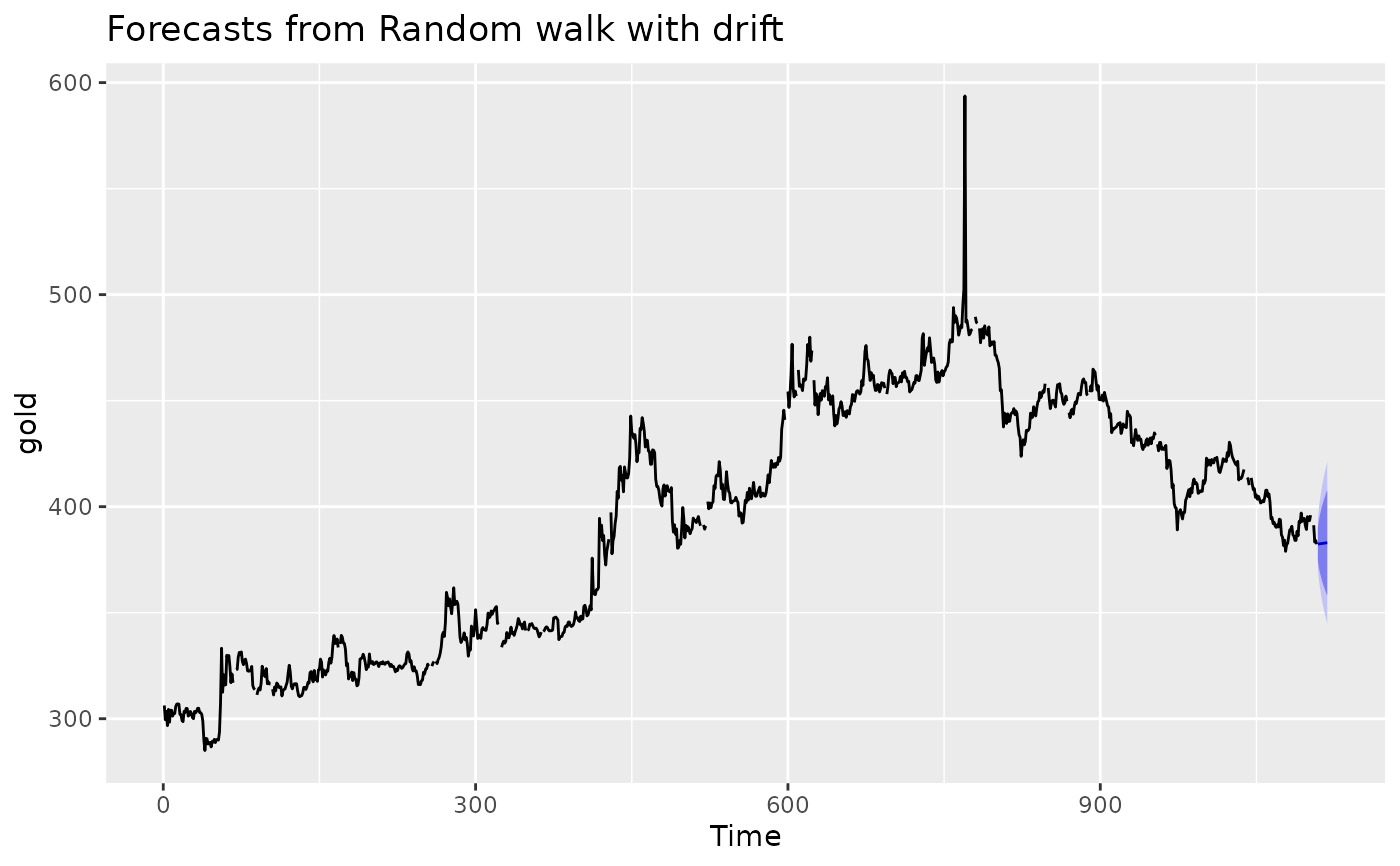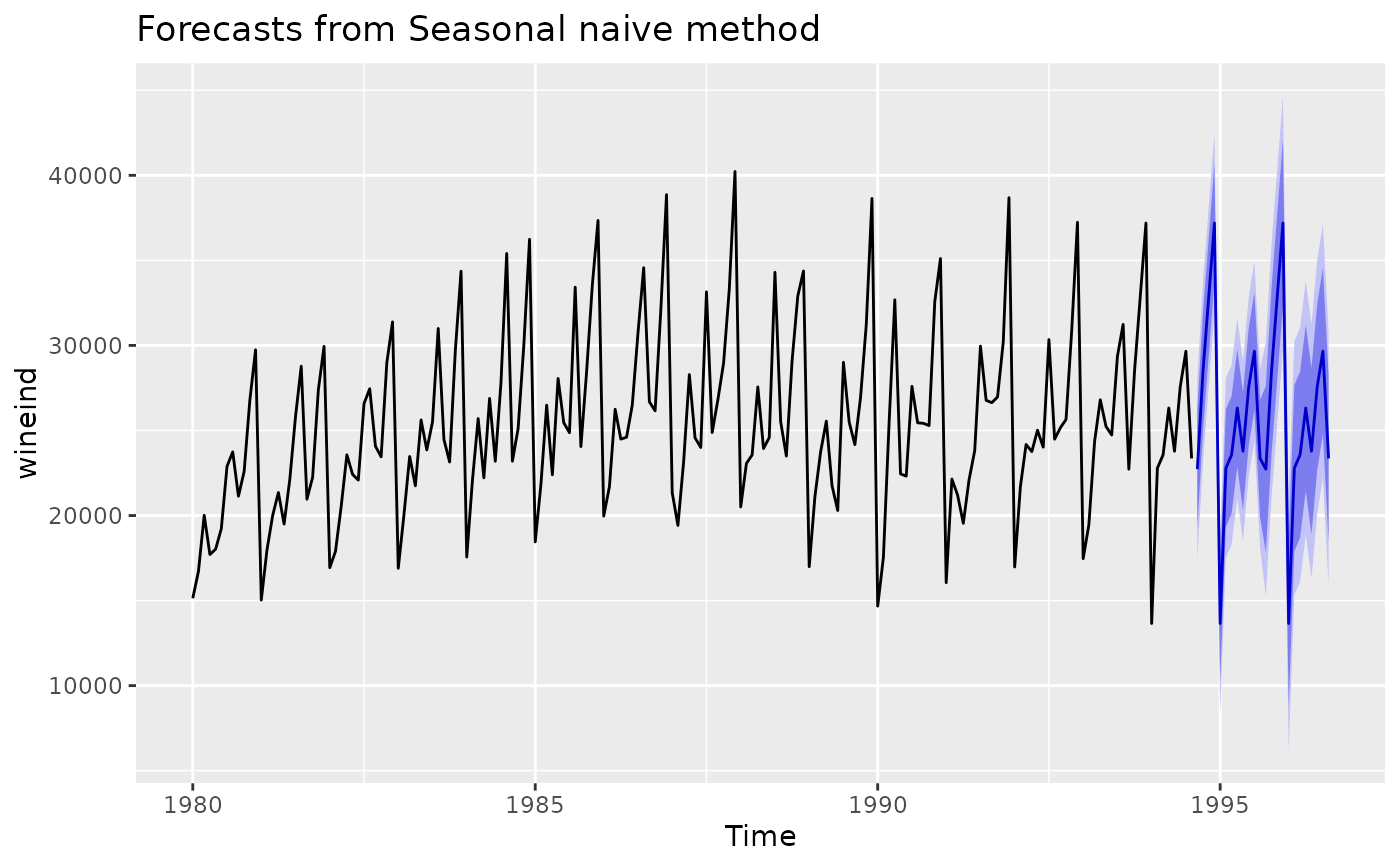Returns forecasts and prediction intervals for a generalized random walk model.
rwf() is a convenience function that combines rw_model() and forecast().
naive() is a wrapper to rwf() with drift=FALSE and lag=1, while
snaive() is a wrapper to rwf() with drift=FALSE and lag=frequency(y).
Usage
# S3 method for class 'rw_model'
forecast(
object,
h = 10,
level = c(80, 95),
fan = FALSE,
simulate = FALSE,
bootstrap = FALSE,
npaths = 5000,
innov = NULL,
lambda = object$lambda,
biasadj = FALSE,
...
)
rwf(
y,
h = 10,
drift = FALSE,
level = c(80, 95),
fan = FALSE,
lambda = NULL,
biasadj = FALSE,
lag = 1,
...,
x = y
)
naive(
y,
h = 10,
level = c(80, 95),
fan = FALSE,
lambda = NULL,
biasadj = FALSE,
...,
x = y
)
snaive(
y,
h = 2 * frequency(x),
level = c(80, 95),
fan = FALSE,
lambda = NULL,
biasadj = FALSE,
...,
x = y
)Arguments
- object
An object of class
rw_modelreturned byrw_model().- h
Number of periods for forecasting. Default value is twice the largest seasonal period (for seasonal data) or ten (for non-seasonal data).
- level
Confidence levels for prediction intervals.
- fan
If
TRUE,levelis set toseq(51, 99, by = 3). This is suitable for fan plots.- simulate
If
TRUE, prediction intervals are produced by simulation rather than using analytic formulae. Errors are assumed to be normally distributed.- bootstrap
If
TRUE, then prediction intervals are produced by simulation using resampled errors (rather than normally distributed errors). Ignored ifinnovis notNULL.- npaths
Number of sample paths used in computing simulated prediction intervals.
- innov
Optional matrix of future innovations to be used in simulations. Ignored if
simulate = FALSE. If provided, this overrides thebootstrapargument. The matrix should havehrows andnpathscolumns.- lambda
Box-Cox transformation parameter. If
lambda = "auto", then a transformation is automatically selected usingBoxCox.lambda. The transformation is ignored if NULL. Otherwise, data transformed before model is estimated.- biasadj
Use adjusted back-transformed mean for Box-Cox transformations. If transformed data is used to produce forecasts and fitted values, a regular back transformation will result in median forecasts. If biasadj is
TRUE, an adjustment will be made to produce mean forecasts and fitted values.- ...
Additional arguments not used.
- y
a numeric vector or univariate time series of class
ts- drift
Logical flag. If
TRUE, fits a random walk with drift model.- lag
Lag parameter.
lag = 1corresponds to a standard random walk (giving naive forecasts ifdrift = FALSEor drift forecasts ifdrift = TRUE), whilelag = mcorresponds to a seasonal random walk where m is the seasonal period (giving seasonal naive forecasts ifdrift = FALSE).- x
Deprecated. Included for backwards compatibility.
Details
The model assumes that
$$Y_t = Y_{t-p} + c + \varepsilon_{t}$$
where \(p\) is the lag parameter, \(c\) is the drift parameter, and \(\varepsilon_t\sim N(0,\sigma^2)\) are iid.
The model without drift has \(c=0\). In the model with drift, \(c\) is estimated by the sample mean of the differences \(Y_t - Y_{t-p}\).
If \(p=1\), this is equivalent to an ARIMA(0,1,0) model with an optional drift coefficient. For \(p>1\), it is equivalent to an ARIMA(0,0,0)(0,1,0)p model.
The forecasts are given by
$$Y_{T+h|T}= Y_{T+h-p(k+1)} + ch$$
where \(k\) is the integer part of \((h-1)/p\). For a regular random walk, \(p=1\) and \(c=0\), so all forecasts are equal to the last observation. Forecast standard errors allow for uncertainty in estimating the drift parameter (unlike the corresponding forecasts obtained by fitting an ARIMA model directly).
The generic accessor functions stats::fitted() and stats::residuals()
extract useful features of the object returned.
forecast class
An object of class forecast is a list usually containing at least
the following elements:
- model
A list containing information about the fitted model
- method
The name of the forecasting method as a character string
- mean
Point forecasts as a time series
- lower
Lower limits for prediction intervals
- upper
Upper limits for prediction intervals
- level
The confidence values associated with the prediction intervals
- x
The original time series.
- residuals
Residuals from the fitted model. For models with additive errors, the residuals will be x minus the fitted values.
- fitted
Fitted values (one-step forecasts)
The function summary can be used to obtain and print a summary of the
results, while the functions plot and autoplot produce plots of the forecasts and
prediction intervals. The generic accessors functions fitted.values and residuals
extract various useful features from the underlying model.
Examples
# Three ways to do the same thing
gold_model <- rw_model(gold)
gold_fc1 <- forecast(gold_model, h = 50)
gold_fc2 <- rwf(gold, h = 50)
gold_fc3 <- naive(gold, h = 50)
# Plot the forecasts
autoplot(gold_fc1)
 # Drift forecasts
rwf(gold, drift = TRUE) |> autoplot()
# Drift forecasts
rwf(gold, drift = TRUE) |> autoplot()
 # Seasonal naive forecasts
snaive(wineind) |> autoplot()
# Seasonal naive forecasts
snaive(wineind) |> autoplot()

